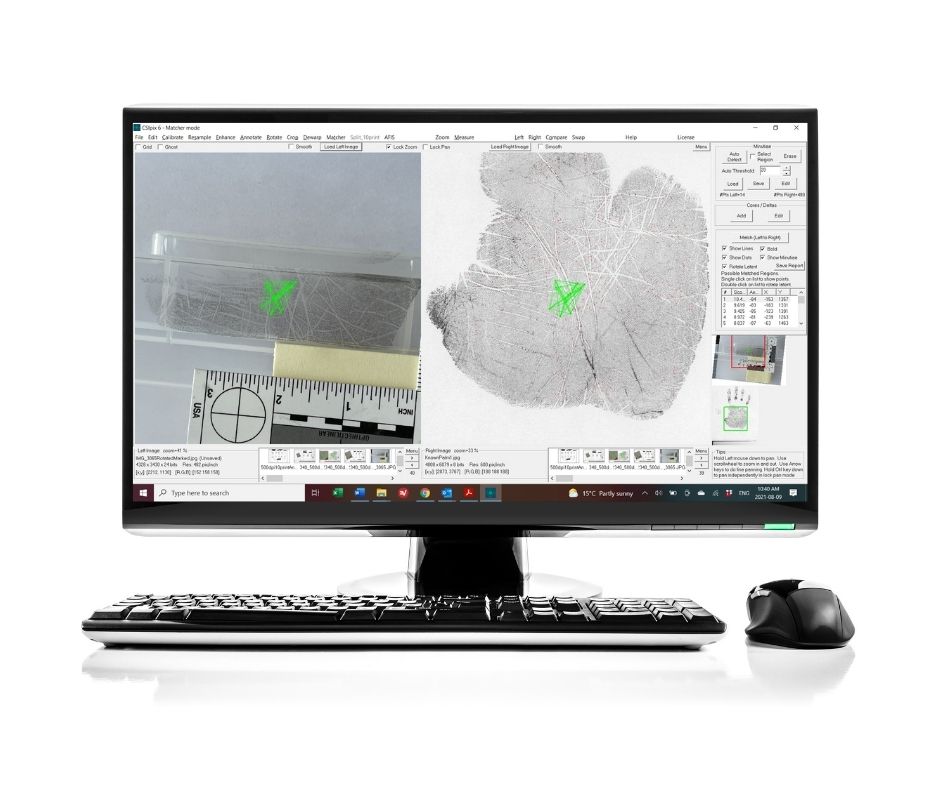September 12, 2022
AFIS technology and automated Matcher software are being used increasingly by forensic laboratories to speed up latent fingerprint and palm print comparison and to improve quality control. In particular, examiners are finding success using CSIpix® Matcher to help identify palm prints, especially when the orientation of the latent is uncertain.
Certified Latent Print Examiner Melissa Lyman with the Oregon State Police recently wrote to tell us of her experience with Matcher:
“The latent was a small, ambiguous palm impression with 14 clear features but without a clear orientation or features that were highly specific/eye-catching. With Matcher I recognized the agreement in the #1 position, and the whole process took me less than 5 minutes. A manual comparison would have taken SO MUCH longer. Thank you!!”
Oregon State Police examiners all have access to Matcher to assist them in locating regions of correspondence between complex latent prints and known standards. Other labs in states, counties and municipalities across the USA have had similar success, as indicated by a lab supervisor from another state:
“The analysts use the Matcher for searching difficult prints when the orientation and/or the anatomical location is in question. One of our analysts has really mastered CSIpix® Matcher and has made some incredible identifications utilizing it.”
The Matcher automatically compares the minutia pattern of a latent print to a known standard and finds the minutia pattern on the standard that best matches the latent. Matcher does an exhaustive incremental 360-degree search of the standard and highlights the best matching minutia pattern on each print. The latent image is rotated so that the minutia pattern on the latent is at the same orientation as the matching pattern on the known. The standard can be a full palm print, a full tenprint, or an individual fingerprint. A latent can also be searched against another latent or in fact against any image containing friction ridges.
In Figures 1 and 2 below which show a palm comparison, the Matcher software found the minutia pattern on the standard that corresponds to the latent, highlighting the patterns in each image and rotating the latent 84 degrees CCW to orient it with the standard. Whether or not the minutia patterns represent an identification or otherwise is, of course, the fingerprint examiner’s decision.

Figure 1. Matcher display showing highlighted minutia patterns (left side) and known (right side) palm prints.

Figure 2. Close-up view of highlighted matching minutia patterns found by the Matcher software.
Melissa Lyman also shared her experience in using Matcher to re-examine some difficult comparisons from a recent comprehensive palm print research study she participated in:
“I did well in this study, making no erroneous exclusions. However, there were a couple of small latent palm impressions in which I reached an Inconclusive decision, but which were actually ground truth Identifications. Because I was participating outside of work and on my own time I did not want to spend the amount of time those comparisons actually required. Once I realized I could get back to the latent and known images, I decided to test Matcher’s abilities…. With each of these “tests”, Matcher located the correct corresponding area in the #1 position.
Many labs implement Matcher in their workflow as a quality control check following manual comparisons, prior to finalizing an exclusion or inconclusive evaluation decision. In cases where labs do not have the labour resources to formally verify exclusions and inconclusive decisions, Matcher can be used as a less labour-intensive means to help avoid missed identifications.
Sign up to receive CSIpix blogs, updates and industry insights.
Time to make the switch?
Then check out CSIpix’s suite of forensic software to streamline your case workflow and search in minutes. Trusted by 650+ forensic labs in over 40 countries. Learn more and start a free 30-day trail today.
